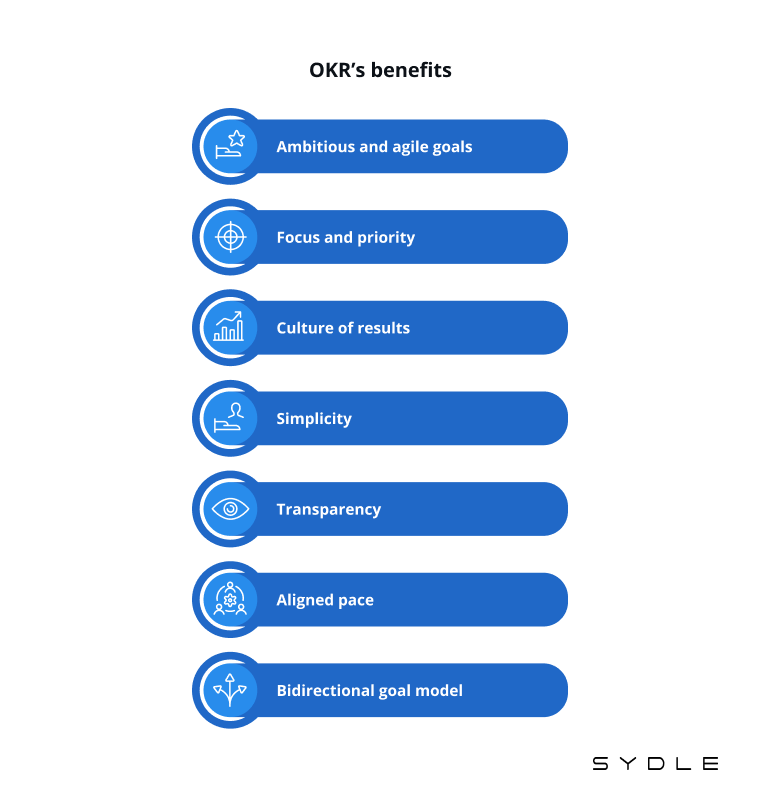ปลดล็อคพลังของ OKR ในระบบโทรคมนาคม: ปฏิวัติประสิทธิภาพและการเชื่อมต่อของคุณเพื่อความสำเร็จที่ไม่มีใครเทียบได้

สารบัญ
- ทำความเข้าใจกับความท้าทายเฉพาะตัวของภาคโทรคมนาคม
- การแนะนำ OKRs ในโทรคมนาคม: ข้อควรพิจารณาที่สำคัญ
- การนำ OKR มาใช้: ขั้นตอนปฏิบัติเพื่อความสำเร็จ
- การเอาชนะความท้าทายและเพิ่มผลลัพธ์สูงสุด
- การวัดผลตอบแทนจากการลงทุน: OKR มีอิทธิพลต่อผลลัพธ์ทางธุรกิจในระบบโทรคมนาคมอย่างไร
- บทสรุป
ในภาคโทรคมนาคมที่มีการแข่งขันสูงในปัจจุบัน ธุรกิจต่างพยายามที่จะก้าวข้ามคู่แข่งโดยมอบการเชื่อมต่อที่ยอดเยี่ยม เพิ่มประสิทธิภาพให้สูงสุด และก้าวล้ำหน้าความก้าวหน้าทางเทคโนโลยี กรอบการทำงานที่เน้นผลลัพธ์ เช่น วัตถุประสงค์และผลลัพธ์หลัก (OKR) ได้กลายมาเป็นเครื่องมือที่มีค่าสำหรับการบรรลุเป้าหมายเหล่านี้ ทำให้สามารถ โทรคมนาคม บริษัทต่างๆ ที่จะกำหนดเป้าหมายที่ชัดเจนและวัดความคืบหน้าในการบรรลุเป้าหมายเหล่านั้น
ทำความเข้าใจกับความท้าทายเฉพาะตัวของภาคโทรคมนาคม
อุตสาหกรรมโทรคมนาคมต้องเผชิญกับความท้าทายหลายประการที่ต้องใช้แนวทางที่มีโครงสร้างในการกำหนดเป้าหมายและวัดผลการปฏิบัติงาน ด้วยเทคโนโลยีที่พัฒนาอย่างรวดเร็ว ความต้องการของลูกค้าที่เปลี่ยนไป และการแข่งขันในตลาดที่รุนแรง บริษัทโทรคมนาคมต้องมีความคล่องตัว สร้างสรรค์ และตอบสนองความต้องการเพื่อให้ทันต่อสถานการณ์
การนำ OKR มาใช้ช่วยให้องค์กรโทรคมนาคมสามารถจัดทีมและกลยุทธ์ให้สอดคล้องกับวัตถุประสงค์ร่วมกัน ส่งเสริมสภาพแวดล้อมการทำงานที่มุ่งเน้นและร่วมมือกันมากขึ้น ด้วยการกำหนดเป้าหมายอย่างชัดเจน บริษัทโทรคมนาคมสามารถปรับกระบวนการทำงานให้มีประสิทธิภาพและเพิ่มประสิทธิภาพความพยายามเพื่อให้บรรลุผลลัพธ์ที่ต้องการ
การแนะนำ OKRs ในโทรคมนาคม: ข้อควรพิจารณาที่สำคัญ
ก่อนที่จะเจาะลึกถึงรายละเอียดของการนำ OKR ไปใช้ โทรคมนาคม บริษัทต่างๆ จะต้องกำหนดคุณค่าหลักและวิสัยทัศน์ของตนเอง องค์ประกอบพื้นฐานเหล่านี้จะชี้นำกระบวนการกำหนดเป้าหมายและช่วยให้แน่ใจว่าวัตถุประสงค์ที่ได้รับจากองค์ประกอบเหล่านี้สอดคล้องกับทิศทางเชิงกลยุทธ์โดยรวมขององค์กร
เมื่อกำหนดค่านิยมหลักและวิสัยทัศน์แล้ว บริษัทโทรคมนาคมสามารถกำหนดเป้าหมายของตนเองได้ เป้าหมายควรมีความทะเยอทะยานแต่ต้องบรรลุได้ เนื่องจากดวงดาวนำทางจะกระตุ้นและมุ่งเน้นความพยายามของทีม เป้าหมายเหล่านี้อาจรวมถึงการขยายการครอบคลุมเครือข่าย การปรับปรุงประสบการณ์ของลูกค้า การเพิ่มความน่าเชื่อถือของบริการ และการเพิ่มกระแสรายได้สำหรับองค์กรโทรคมนาคม
การแบ่งวัตถุประสงค์เหล่านี้ออกเป็นผลลัพธ์หลักถือเป็นสิ่งสำคัญในการติดตามความคืบหน้าอย่างมีประสิทธิภาพ ผลลัพธ์หลักคือตัวชี้วัดหรือเหตุการณ์สำคัญเฉพาะเจาะจงที่ช่วยให้องค์กรสามารถวัดความสำเร็จในการบรรลุวัตถุประสงค์ได้ ตัวอย่างเช่น ผลลัพธ์หลักสำหรับวัตถุประสงค์ในการขยายการครอบคลุมเครือข่ายอาจเป็นการเพิ่มจำนวนเสาโทรศัพท์มือถือที่นำไปใช้งานเป็นเปอร์เซ็นต์ที่แน่นอนภายในกรอบเวลาที่กำหนด
เพื่อให้แน่ใจว่ามีความรับผิดชอบและเป็นเจ้าของ บริษัทโทรคมนาคมควรมอบหมายความรับผิดชอบสำหรับวัตถุประสงค์และผลลัพธ์หลักแต่ละอย่างให้กับทีมหรือบุคคลที่เกี่ยวข้อง การทำเช่นนี้จะทำให้ทุกคนเข้าใจบทบาทของตนในการมีส่วนสนับสนุนต่อความสำเร็จโดยรวม ส่งเสริมให้เกิดความรู้สึกเป็นเจ้าของและความรับผิดชอบร่วมกัน
เพิ่มประสิทธิภาพการสื่อสารทางไกลของคุณด้วย OKR! 📶💪 ค้นพบวิธีเพิ่มประสิทธิภาพและการเชื่อมต่อในอุตสาหกรรม: https://okrinstitute.org/okr-resources/ #OKRs #Telecomความสำเร็จ
การนำ OKR มาใช้: ขั้นตอนปฏิบัติเพื่อความสำเร็จ
การนำ OKR มาใช้อย่างมีประสิทธิผลต้องอาศัยแนวทางที่มีโครงสร้างชัดเจน ต่อไปนี้คือขั้นตอนปฏิบัติบางประการที่บริษัทโทรคมนาคมสามารถปฏิบัติตามเพื่อนำ OKR มาใช้ได้อย่างประสบความสำเร็จ:
ประการแรก การกำหนดวัตถุประสงค์ที่ชัดเจน ทะเยอทะยาน และวัดผลได้ ซึ่งสอดคล้องกับอุตสาหกรรมโทรคมนาคมถือเป็นสิ่งสำคัญ วัตถุประสงค์แต่ละข้อควรมีความเฉพาะเจาะจง เป็นรูปธรรม และดำเนินการได้จริง โดยต้องมั่นใจว่าสอดคล้องกับกลยุทธ์และวิสัยทัศน์โดยรวมขององค์กร
การกำหนดผลลัพธ์ที่สำคัญต้องควบคู่ไปกับการตั้งวัตถุประสงค์ ผลลัพธ์ที่สำคัญควรวัดผลได้ มีกรอบเวลา และวัดได้โดยตรง โดยการกำหนดตัวชี้วัดที่ชัดเจน บริษัทโทรคมนาคมสามารถติดตามความคืบหน้าได้อย่างแม่นยำและตัดสินใจตามข้อมูลตลอดกระบวนการนำ OKR ไปใช้
การสื่อสารและการจัดแนวทางมีบทบาทสำคัญในการนำ OKR ไปใช้ได้อย่างมีประสิทธิผล วัตถุประสงค์แบบเรียงซ้อนทั่วทั้งองค์กรช่วยให้ทีมงานและบุคคลต่างๆ เข้าใจบทบาทของตนในการบรรลุเป้าหมายที่กว้างขึ้น การตรวจสอบและการสื่อสารอย่างต่อเนื่องเป็นประจำช่วยระบุความท้าทาย ให้การสนับสนุน และให้แน่ใจว่า OKR ยังคงมีความเกี่ยวข้องและสอดคล้องกับธรรมชาติที่เปลี่ยนแปลงไปของอุตสาหกรรมโทรคมนาคม
การใช้เครื่องมือเทคโนโลยีสามารถเพิ่มประสิทธิภาพการใช้งานและการจัดการ OKR ได้อย่างมาก การใช้ซอฟต์แวร์ OKR เฉพาะหรือแพลตฟอร์มการจัดการโครงการสามารถปรับปรุงกระบวนการติดตามและรายงานข้อมูล ทำให้สามารถอัปเดตความคืบหน้าแบบเรียลไทม์และอำนวยความสะดวกในการทำงานร่วมกันระหว่างทีมต่างๆ
การเอาชนะความท้าทายและเพิ่มผลลัพธ์สูงสุด
การนำ OKR มาใช้ในภาคโทรคมนาคมอาจไม่ใช่เรื่องที่ปราศจากความท้าทาย อย่างไรก็ตาม องค์กรต่างๆ สามารถดำเนินขั้นตอนเฉพาะเจาะจงเพื่อเอาชนะอุปสรรคเหล่านี้และเพิ่มประโยชน์ของ OKR ให้สูงสุดได้:
ประการแรก การแก้ไขอุปสรรคที่อาจเกิดขึ้นใน การนำ OKRs ไปใช้ในภาคโทรคมนาคม เป็นสิ่งสำคัญ ความท้าทายบางประการอาจรวมถึงการต่อต้านการเปลี่ยนแปลง การขาดความสอดคล้องกันระหว่างแผนก หรือความยากลำบากในการกำหนดวัตถุประสงค์เฉพาะ การระบุความท้าทายเหล่านี้ล่วงหน้าจะช่วยให้องค์กรสามารถพัฒนากลยุทธ์เพื่อรับมือกับความท้าทายเหล่านี้โดยตรง ส่งเสริมให้กระบวนการนำ OKR ไปปฏิบัติราบรื่นยิ่งขึ้น
การติดตามอย่างต่อเนื่อง วงจรข้อเสนอแนะ และการตรวจสอบเป็นประจำนั้นมีค่าอย่างยิ่งในการรับรองการนำ OKR มาใช้อย่างประสบความสำเร็จ บริษัทโทรคมนาคมสามารถส่งเสริมสภาพแวดล้อมของการปรับปรุงอย่างต่อเนื่องและสร้างพื้นที่สำหรับการแก้ไขเมื่อจำเป็นได้ด้วยการให้การสนับสนุน คำแนะนำ และข้อเสนอแนะอย่างต่อเนื่อง
การสร้างวัฒนธรรมแห่งความโปร่งใส ความร่วมมือ และการปรับปรุงอย่างต่อเนื่องถือเป็นสิ่งสำคัญในการขับเคลื่อนการปฏิบัติตาม OKR และความก้าวหน้าในภาคส่วนโทรคมนาคม การส่งเสริมการสื่อสารแบบเปิด การยอมรับการมีส่วนสนับสนุนของแต่ละบุคคลและทีม และการฉลองเหตุการณ์สำคัญร่วมกันจะช่วยส่งเสริมการปลูกฝังทัศนคติเชิงบวกและ สภาพแวดล้อมการทำงานที่เน้นผลลัพธ์.
การวัดผลตอบแทนจากการลงทุน: OKR มีอิทธิพลต่อผลลัพธ์ทางธุรกิจในระบบโทรคมนาคมอย่างไร
การนำ OKR ไปใช้ในภาคโทรคมนาคมสามารถส่งผลโดยตรงต่อผลลัพธ์ทางธุรกิจต่างๆ ได้ องค์กรต่างๆ สามารถขับเคลื่อนการเติบโตของรายได้ ความพึงพอใจของลูกค้า และการปรับปรุงส่วนแบ่งการตลาดได้โดยการกำหนดวัตถุประสงค์ที่ชัดเจนและติดตามผลลัพธ์ที่สำคัญ

ตัวอย่างเช่น การใช้กรอบงาน OKR เพื่อปรับปรุงการครอบคลุมเครือข่าย องค์กรสามารถขยายฐานลูกค้า เจาะตลาดใหม่ และเพิ่มช่องทางรายได้ ในทำนองเดียวกัน การปรับปรุงฐานลูกค้า ประสบการณ์สามารถนำไปสู่อัตราการรักษาลูกค้าที่สูงขึ้นเพิ่มความภักดีต่อแบรนด์ และปรับปรุงมาตรวัดความพึงพอใจของลูกค้าโดยรวม
การนำ OKR มาใช้ทำให้บริษัทโทรคมนาคมมีแนวทางที่ชัดเจนในการส่งเสริมนวัตกรรมและการมุ่งเน้นเชิงกลยุทธ์ ช่วยให้องค์กรต่างๆ จัดทีมและทรัพยากรให้สอดคล้องกับเป้าหมายร่วมกัน ส่งผลให้พนักงานสามารถมีส่วนสนับสนุนการเติบโตและความสำเร็จของตนได้โดยตรง
บทสรุป
ในภาคส่วนโทรคมนาคมที่มีการเปลี่ยนแปลงอย่างรวดเร็วและมีการแข่งขันสูงในปัจจุบัน OKR นำเสนอโซลูชันสำหรับการปรับกระบวนการทำงาน ขับเคลื่อนการเติบโต และเพิ่มประสิทธิภาพ โดยการจัดทีมให้สอดคล้องกับวัตถุประสงค์ที่ทะเยอทะยานและผลลัพธ์ที่สำคัญที่วัดผลได้ บริษัทโทรคมนาคมสามารถประสบความสำเร็จในการส่งมอบการเชื่อมต่อที่ยอดเยี่ยม ประสบการณ์ที่น่าพึงพอใจของลูกค้า และก้าวล้ำนำหน้าผู้อื่น
องค์กรโทรคมนาคมสามารถนำ OKR ไปใช้ได้อย่างประสบความสำเร็จและเอาชนะความท้าทายต่างๆ ที่อาจเกิดขึ้นได้ โดยคำนึงถึงความโปร่งใส การทำงานร่วมกัน และการปรับปรุงอย่างต่อเนื่อง การนำ OKR ไปใช้ในภาคส่วนโทรคมนาคมจึงมีศักยภาพที่จะ... ผลกระทบต่อผลลัพธ์ทางธุรกิจ และขับเคลื่อนความสำเร็จในระยะยาวอย่างมีนัยสำคัญ